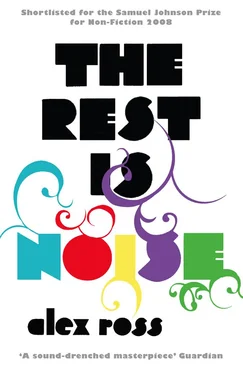Bartók’s most intense encounter with the Folk took place in 1907, when he went to the Eastern Carpathian Mountains, in Transylvania, to gather songs from Hungarian-speaking Székely villagers. Personal upheaval added urgency to the mission; the composer had fallen in love with a nineteen-year-old violinist named Stefi Geyer, who received his advances first with bemusement and then with alarm. Both the letters he wrote to Geyer that summer and his meticulous notes on Transylvanian songs give the impression that a fenced-off soul is opening itself to the chaos of the outer world.
Like Grainger in England, Bartók brought with him an Edison cylinder, and he listened as the machine listened. He observed the flexible tempo of sung phrases, how they would accelerate in ornamental passages and taper off at the end. He saw how phrases were seldom symmetrical in shape, how a beat or two might be added or subtracted. He savored “bent” notes—shadings above or below the given note—and “wrong” notes that added flavor and bite. He understood how decorative figures could evolve into fresh themes, how common rhythms tied disparate themes together, how songs moved in circles instead of going from point A to point B. Yet he also realized that folk musicians could play in absolutely strict tempo when the occasion demanded it. He came to understand rural music as a kind of archaic avant-garde, through which he could defy all banality and convention.
Emotional rejection can have a radicalizing effect, as Schoenberg’s history in 1907 and 1908 suggests. Bartók, pining for the unavailable Stefi, swung away from Romantic tonality in those same two years. The Violin Concerto No. 1, his main work of this period, shows him still in thrall to a Richard Strauss aesthetic, with a five-note theme representing his beloved at the head of the piece. He planned but did not compose a third movement, which would have shown the “hateful” side of the unfortunate girl. Some of that negative energy spills out in the Fourteen Bagatelles for piano, written in the spring of 1908. A kind of substitution of love objects occurs: in place of Stefi’s leitmotif there are now rusty shards of folk melody, showing the impact of the Transylvanian trip and other research expeditions. The Woman becomes the Folk.
The first Bagatelle begins with a radical harmonic break: the right hand plays roughly in C-sharp minor while the left plays in something like the key of C (in the Phrygian mode). This is “polytonality” or “polymodality,” the juxtaposition of two or more key-areas, and it will play a significant role in early-and mid-twentieth-century music. Bartók probably derived the practice from Strauss and Debussy, but he also liked to attribute it to folk players, who periodically wandered free from their accompanying harmonies.
The Bagatelles, together with subsequent works such as the Two Elegies, Allegro barbaro, the First String Quartet, and the opera Bluebeard’s Castle, veer close to atonality. They make frequent use of Schoenberg’s searing motto chord of two fourths separated by a tri-tone. But Bartók’s ardor for folk melodies prevented him from going over the brink. As the musicologist Judit Frigyesi observes, Hungarian modernists were not prone to annihilating rage of the Viennese type; instead, they sought higher unities, transcendent reconciliations. The philosopher and critic Georg Lukács put it this way: “The essence of art is form: it is to defeat oppositions, to conquer opposing forces, to create coherence from every centrifugal force, from all things that have been deeply and eternally alien to one another before and outside this form. The creation of form is the last judgment over things, a last judgment that redeems all that could be redeemed, that enforces salvation on all things with divine force.” Bartók, likewise, talked about the “highest emotions,” a “great reality.” The artist in his loneliness need not bring about Vienna-style antagonism and scandal; instead, Frigyesi writes, he can stand in for all humanity, becoming a “metaphor for wholeness.”
Bartók’s quest led him both onward and inward. In the first days of June 1913, he boarded a steamer in Marseille, bound for Algeria. His ultimate destination was Biskra, on the northern edge of the Sahara, where, seven years before, Henri Matisse had found the inspiration for his raw, sensual Blue Nude. The trip lasted only two weeks: the composer fell ill with fever and had to retreat to Algiers. He hoped to return the following summer, and researched diets that would have allowed him to stay healthy. But the onset of the First World War put a stop to his plans. His wax-cylinder recordings of North African music remained a prize possession and led to a landmark ethnomusicological essay. They also furnished new compositional ideas, particularly in the area of rhythm. Bartók wrote from Algeria: “The Arabs accompany almost all their songs with percussion instruments; sometimes in a very complicated rhythm (it is chiefly varying accentuations of equal bar lengths that produce the different rhythmic patterns).” This could serve as a description of “The Augurs of Spring” in Stravinsky’s Rite, whose first production was still playing to giddy Paris crowds as Bartók set out for Africa.
Maurice Ravel is a special case among turn-of-the-century “realists.” He was a man both urban and urbane, disinclined to go wandering up a mountainside with an Edison cylinder on his back. Yet, during his brief and brilliant career, he drew on a sizable library of folk material—variously, Spanish, Basque, Corsican, Greek, Hebrew, Javanese, and Japanese. He, too, was a phonographic listener, sensitive to microscopic details of phrasing, texture, and pulse. A gentleman flaneur with unusual powers of empathy, Ravel could spend his day as a man of the crowd, then reconstruct the experience in the privacy of his garret.
Commonly considered the most purely French of composers, Ravel was in fact something of a cultural mutt, part Basque and part Swiss. Although he was taken to Paris when he was four months old, his Basque origins held sway over his imagination, the connection maintained in the songs his mother sang for him. Manuel de Falla judged Ravel’s Spanish-themed works “subtly authentic,” which is a good general description of the composer’s music as a whole. Ravel’s father was a Swiss engineer who helped to pioneer, in unsung ways, the automobile; the Ravel prototype of a gas-powered car perished during the German bombardment of Paris in the Franco-Prussian War. In a sense, Ravel’s music split the difference between his parents’ worlds—his mother’s memories of a folkish past, his father’s dreams of a mechanized future.
In a series of piano works in the first de cade of the new century, Ravel carried out a kind of velvet revolution, renewing the language of music without disturbing the peace. In Jeux d’eau, melody and accompaniment dematerialize into splashing, skittering lines, imitating the movement of water in a fountain. In “Valley of the Bells,” from the cycle Miroirs, novel notation is used to enhance the impression of bell tones resonating in space: the music is spread over three rather than two staves, each line moving at an independent tempo. In “Le Gibet,” from Gaspard de la nuit, ghostly figures rise and fall around a continuously tolling B-flat—a structure that was in itself a new kind of musical narrative, one of proto-minimalist repetition. Falla, in his writings on flamenco, points out that melodies of the “deep song” type often rotate around an obsessively repeated note, and pieces such as “Le Gibet” may allude to the great Andalusian dance, although the one-note pattern could just as well have come from Gregorian chant. Some years later, in the 1928 showpiece Bolero, Ravel would take the aesthetic of repetition to the extreme: for fifteen minutes the orchestra hammers away at a theme in the key of C.
Читать дальше












